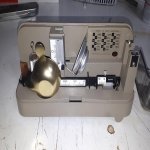- Location
- Western Manitoba
Hey thanks somehow I didn't see this post earlier!! So those nuts are for calibrating good to know!!
As mentioned - I have been doing that procedure so long, I have forgotten where that came from - really hope it was an instruction sheet or I have been making busy work for myself for 40 years. Screw that goes through the foot, and two nuts on that threaded stem on right end of beam - together, they "calibrate" the scale. Plus I feel better having a "check weight" - was and am too cheap to buy "check weight set" with thousands of bullets already here. So I picked one out of five several years ago - all weighed on other scales - to get the "one" that was closest to what the package said - 55 grain - Sierra brand, I think, bought for the 22-250 I used to have - is sort of in the range of weight that I want to weigh powder the most often. I want no weight in pan reading "0", and with 55.0 set on the beam weights, and a 55.0 grain "check weight" in the pan, again I want the pointer at "0". Maybe I am doing it wrong.
I learned that most anything to be measured, weighed, etc. needs to be done with a calibrated tool, or the result is a "make believe number". So, Mitutoyo micrometer comes with a 1.0000" standard - I use that, before measuring something that I want a "real" number. My cheap callipers from NAPA say "accurate to .001" - I have never "calibrated" it - useless that the readout goes to 4 digits - any measurement taken is truly only within .001" of that value. It reads out to "tenths", but can not repeatedly measure that accurately - close the tool every third measurement and "re-zero-ing" by several thou, again - could almost get as dependable results with a tape measure or a ruler... I actually trust my old Craftsman vernier calliper with a magnify glass, more than I do that inexpensive electronic thing. But, is quick to use, and for some purposes, "close enough".
Last edited:












































































